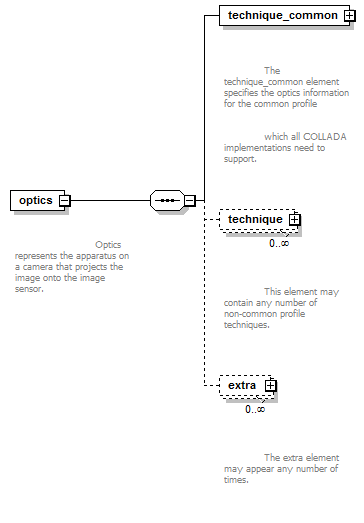<xs:element name="optics">
<xs:annotation>
<xs:documentation>Optics represents the apparatus on a camera that projects the image onto the image sensor.</xs:documentation>
</xs:annotation>
<xs:complexType>
<xs:sequence>
<xs:element name="technique_common">
<xs:annotation>
<xs:documentation>The technique_common element specifies the optics information for the common profile which all COLLADA implementations need to support.</xs:documentation>
</xs:annotation>
<xs:complexType>
<xs:choice>
<xs:element name="orthographic">
<xs:annotation>
<xs:documentation>The orthographic element describes the field of view of an orthographic camera.</xs:documentation>
</xs:annotation>
<xs:complexType>
<xs:sequence>
<xs:choice>
<xs:sequence>
<xs:element name="xmag" type="targetable_float_type">
<xs:annotation>
<xs:documentation>The xmag element contains a floating point number describing the horizontal magnification of the view.</xs:documentation>
</xs:annotation>
</xs:element>
<xs:choice minOccurs="0">
<xs:element name="ymag" type="targetable_float_type">
<xs:annotation>
<xs:documentation>The ymag element contains a floating point number describing the vertical magnification of the view. It can also have a sid.</xs:documentation>
</xs:annotation>
</xs:element>
<xs:element name="aspect_ratio" type="targetable_float_type">
<xs:annotation>
<xs:documentation>The aspect_ratio element contains a floating point number describing the aspect ratio of the field of view. If the aspect_ratio element is not present the aspect ratio is to be calculated from the xmag or ymag elements and the current viewport.</xs:documentation>
</xs:annotation>
</xs:element>
</xs:choice>
</xs:sequence>
<xs:sequence>
<xs:element name="ymag" type="targetable_float_type"/>
<xs:element name="aspect_ratio" type="targetable_float_type" minOccurs="0"/>
</xs:sequence>
</xs:choice>
<xs:element name="znear" type="targetable_float_type">
<xs:annotation>
<xs:documentation>The znear element contains a floating point number that describes the distance to the near clipping plane. The znear element must occur exactly once.</xs:documentation>
</xs:annotation>
</xs:element>
<xs:element name="zfar" type="targetable_float_type">
<xs:annotation>
<xs:documentation>The zfar element contains a floating point number that describes the distance to the far clipping plane. The zfar element must occur exactly once.</xs:documentation>
</xs:annotation>
</xs:element>
</xs:sequence>
</xs:complexType>
</xs:element>
<xs:element name="perspective">
<xs:annotation>
<xs:documentation>The perspective element describes the optics of a perspective camera.</xs:documentation>
</xs:annotation>
<xs:complexType>
<xs:sequence>
<xs:choice>
<xs:sequence>
<xs:element name="xfov" type="targetable_float_type">
<xs:annotation>
<xs:documentation>The xfov element contains a floating point number describing the horizontal field of view in degrees.</xs:documentation>
</xs:annotation>
</xs:element>
<xs:choice minOccurs="0">
<xs:element name="yfov" type="targetable_float_type">
<xs:annotation>
<xs:documentation>The yfov element contains a floating point number describing the verticle field of view in degrees.</xs:documentation>
</xs:annotation>
</xs:element>
<xs:element name="aspect_ratio" type="targetable_float_type">
<xs:annotation>
<xs:documentation>The aspect_ratio element contains a floating point number describing the aspect ratio of the field of view. If the aspect_ratio element is not present the aspect ratio is to be calculated from the xfov or yfov elements and the current viewport.</xs:documentation>
</xs:annotation>
</xs:element>
</xs:choice>
</xs:sequence>
<xs:sequence>
<xs:element name="yfov" type="targetable_float_type"/>
<xs:element name="aspect_ratio" type="targetable_float_type" minOccurs="0"/>
</xs:sequence>
</xs:choice>
<xs:element name="znear" type="targetable_float_type">
<xs:annotation>
<xs:documentation>The znear element contains a floating point number that describes the distance to the near clipping plane. The znear element must occur exactly once.</xs:documentation>
</xs:annotation>
</xs:element>
<xs:element name="zfar" type="targetable_float_type">
<xs:annotation>
<xs:documentation>The zfar element contains a floating point number that describes the distance to the far clipping plane. The zfar element must occur exactly once.</xs:documentation>
</xs:annotation>
</xs:element>
</xs:sequence>
</xs:complexType>
</xs:element>
</xs:choice>
</xs:complexType>
</xs:element>
<xs:element name="technique" type="technique_type" minOccurs="0" maxOccurs="unbounded">
<xs:annotation>
<xs:documentation>This element may contain any number of non-common profile techniques.</xs:documentation>
</xs:annotation>
</xs:element>
<xs:element name="extra" type="extra_type" minOccurs="0" maxOccurs="unbounded">
<xs:annotation>
<xs:documentation>The extra element may appear any number of times.</xs:documentation>
</xs:annotation>
</xs:element>
</xs:sequence>
</xs:complexType>
</xs:element> |
